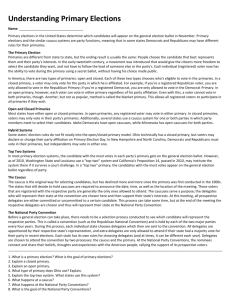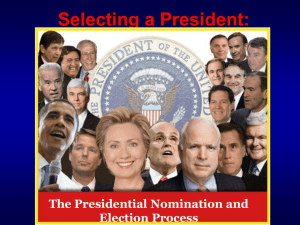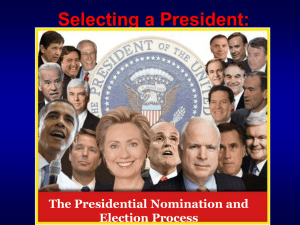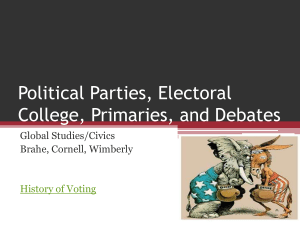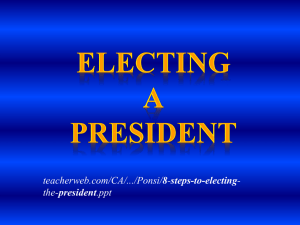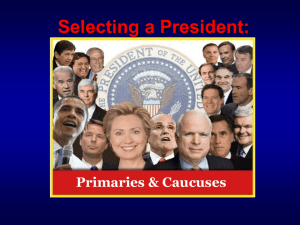The Presidential Nomination and Election Process
advertisement
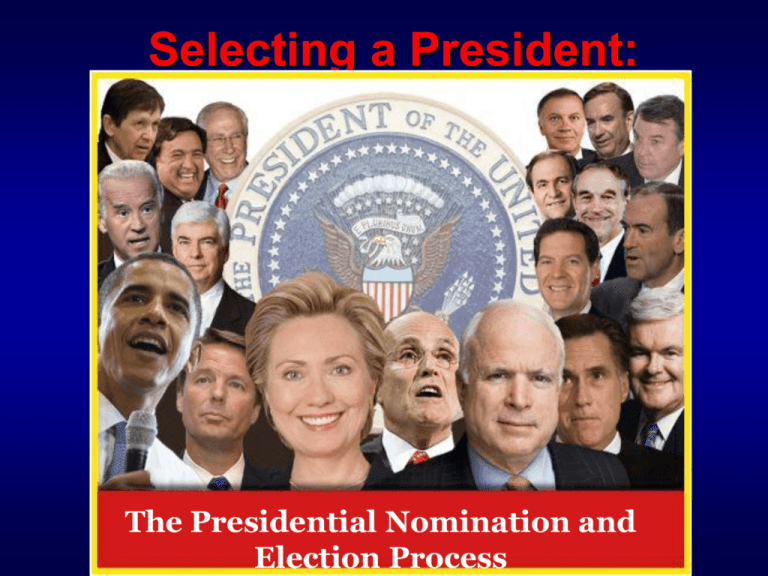
Selecting a President: The Presidential Nomination and Election Process Presidential Selection Stage 1: Caucuses & Primaries The Battle for the Party Faithful Stage 2: Nominating Conventions “Glorified Infomercials?” Stage 3: General Election The Fight for the Center Stage 4: Electoral College Power to the People? Announcing candidacy & organizing • Candidates officially enter the “race” to the Presidency • Campaign is organized for upcoming events: – Network of workers/volunteers (phone calls, publicity, planners, etc.) – Accounts created for future fundraising abcnews.go.com Pre-primary fundraising, campaigning, and debating • Candidates begin fundraising for the upcoming spring primary/caucus season • Campaigning for the party primary/caucus is in full swing during this time • Debates will be held between the main contenders washingtonpost.com Stage 1: Caucuses Barrack Obama campaigns in Iowa Closed meeting of party members in each state Delegates select the party’s choice for presidential candidate Currently used in only six states Stage 1: Caucuses Hilary Clinton (D) and Rudy Guilliani (R) campaigning in Iowa The Iowa Caucus is the first primary/caucus and last year was held on January 3, 2008. Considering Iowa is a relatively small state, why are the Iowa caucuses so important?? Stage 1: Primaries Presidential Primary Elections - special elections in which voters select candidates to be the party’s nominee for president in the general election. Primary Season January - June Who Decides? - State party organizations for the most part decide the rules for the primaries in a particular state. Types of Primaries: Closed Primaries Open Primaries Mitt Romney campaigning in New Hampshire Closed Primary • Voters may vote in a party's primary only if they are registered members of that party Open Primary • A registered voter may vote in any party primary regardless of his or her own party affiliation. Methods of Selecting Presidential Delegates by State Which is most popular? Why?? 2008 Open & Closed Primaries Virginia has a “modified open primary” Iowa Caucus Nationaljournal.c om • First major electoral event in the election process. • Candidates campaign in Iowa months before the caucus – Ads, paid staffers, and publicity is centered around the many precincts in Iowa • The winner of the Iowa caucus has served as an indication of the person who will win their parties nomination New Hampshire Primary • First primary of election year • Focused upon by candidates – Media attention – Early success in contests / must perform well to continue in race nhhistory.org Importance of Early Caucuses and Primaries • These states are small but play a big role • They do not decide who IS the nominee for each party • They decide who ISN’T the nominee. • They significantly narrow the field of candidates • • • • Iowa New Hampshire Nevada South Carolina SUPER TUESDAY • In 2008, states realized that the sooner they go, the more say they have in who gets nominated. • Both the Democrat and Republican Parties the earliest date for which a state can have its primary. • Many states had their primaries on this date SUPER TUESDAY • This became known as SUPER TUESDAY. • Most experts predicted that this date would decide the nominee early. • This was not the case – 2008: Hilary vs. Obama – 2012: Romney vs. Santorum Stage 2: Presidential Nominating Conventions Barack and Michelle Obama at the 2004 Democratic National Convention Nominating Conventions • An assembly held by political parties every four years • Usually held in late summer before the general election in November George W. and Laura Bush at the 2000 Republican Convention Purposes of Nominating Conventions 1980 Republican National Convention in Detroit, Michigan 1. At the convention the party adopts a platform to unify support behind common goals. 2. Delegates to the convention elect that party’s nominees for President and Vice-president. What is a Party Platform? • Platform - a statement of principles and objectives a political party and a candidate support • Plank - Individual topics in a party’s platform (ex: abortion, war in Iraq) Who are Delegates? Delegate - A voting representative to the party nominating convention Delegate Selection Proportional System Primary system used by the Democratic Party Candidates get a % of delegates based on the popular vote Winner-take-all System System used in most Republican primaries The winner of the popular vote in that state receives all that state’s delegates Similar to electoral college Democratic Party Rules: Two Types of Delegates Pledged Delegates v. Superdelegates Pledged Delegates Pledged delegates are required to vote at the convention based on the popular vote in their state (they have to listen to the people) Pledged delegates count during the 2008 Democratic primaries Superdelegates Members of the Democratic Party establishment who serve as unpledged (??) delegates at the party convention They are free to vote for any candidate at the convention (don’t have to listen to the popular vote in their state) Superdelegates By John Trever, The Albuquerque Journal 03/30/2008 http://www.politicalcartoons.com/ Convention Speeches: The Keynote Address The speech given at the convention that embodies that party’s core message Extremely important event – can propel a politicians career Do you know who gave the 2004 Keynote Address at the Democratic Convention??? Current President, (Then a Senator) Barrack Obama gives the 2004 DNC Keynote Address The Acceptance Address 1960 presidential candidates John F. Kennedy and Richard M. Nixon deliver their Acceptance Addresses at their party’s national convention Given at the final day of the convention winning candidate formally accepts the party’s nomination for president Huge media event - Acceptance Address is always televised by the major networks 1992 Democratic National Convention in New York City Critics say that party nominating conventions have become nothing more than infomercials. What do you think? Stage 3: General Election • Candidates ACTIVELY campaign by… • (Basically do ANYTHING that they think will get them more voters) Raise money In the 2008 campaign, Barack Obama raised over $600 million dollars – more than any other candidate ever—most of it through small, single online donations Run ads (TV, radio, mail, internet etc) Participate in Debates Hold rallies and give speeches Fall Campaign After convention to Election Day • Candidates travel from state to state (speaking, rallies fundraising, etc.) • Focus on swing states (states that are contested) • Run TV ads to increase name recognition, spread ideas, “mud-sling” • Debates held against opponent (media attention, show “likeability”, appear presidential, etc.) thesoundsofhistory.com Campaign Finance • The McCain-Feingold Act (2002) sought to limit campaign corruption by limiting the amount of money that could be donated by individuals and organizations. • Citizen’s United Decision (2010) struck down key limitations in McCain-Feingold allowing corporations and organizations to spend and donate unlimited money. Campaign Finance • At the beginning of the 2012 election season, many experts estimated that a candidate would need to raise $1 billion in order to run a successful campaign for the presidency. • So far: • Romney: $771.7 million • Obama: $834.7 million General Election • Held on the Tuesday after the first Monday in November – November 2-8 • Eligible citizens of the U.S. cast votes for the candidate of their choice for President. • Popular vote winner in each state helps determine the electors who will cast the official vote in the Electoral College Time.com Stage 4: Electoral College We’ll talk about it in more detail Electoral College December – After General Election • Distributes votes to states based upon # of senators & representatives • State’s popular vote winner earns all Electoral votes of state • Must earn majority (270) of Electoral votes to win election • Map: 2012 distribution • Used originally to “check” voters (uneducated & uniformed) census.gov
